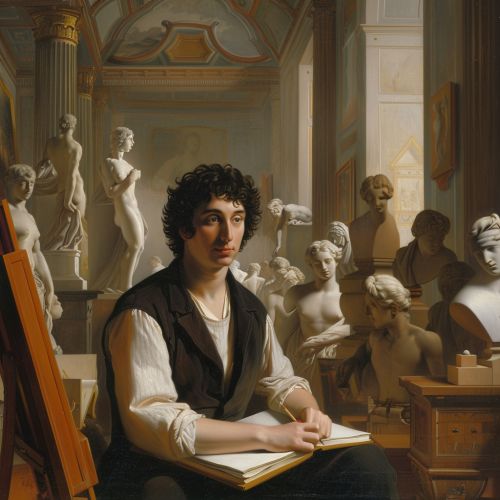Jean-Auguste-Dominique Ingres: Difference between revisions
(Created page with "== Early Life == Jean-Auguste-Dominique Ingres was born on August 29, 1780, in Montauban, Tarn-et-Garonne, France. He was the first of seven children born to Jean-Marie-Joseph Ingres, a successful sculptor, and his wife, Anne Moulet. His father, a man of modest means, was able to provide a comfortable life for his family through his work. Ingres' early exposure to the arts, particularly sculpture, would prove influential in his development as a painte...") |
No edit summary |
||
| Line 2: | Line 2: | ||
Jean-Auguste-Dominique Ingres was born on August 29, 1780, in Montauban, [[Tarn-et-Garonne|Tarn-et-Garonne]], France. He was the first of seven children born to Jean-Marie-Joseph Ingres, a successful sculptor, and his wife, Anne Moulet. His father, a man of modest means, was able to provide a comfortable life for his family through his work. Ingres' early exposure to the arts, particularly sculpture, would prove influential in his development as a painter. | Jean-Auguste-Dominique Ingres was born on August 29, 1780, in Montauban, [[Tarn-et-Garonne|Tarn-et-Garonne]], France. He was the first of seven children born to Jean-Marie-Joseph Ingres, a successful sculptor, and his wife, Anne Moulet. His father, a man of modest means, was able to provide a comfortable life for his family through his work. Ingres' early exposure to the arts, particularly sculpture, would prove influential in his development as a painter. | ||
[[Image:Detail-77931.jpg|thumb|center|A painting of a young Ingres, sitting in a room filled with sculptures, holding a sketchbook.]] | |||
== Education == | == Education == | ||
Revision as of 12:19, 8 May 2024
Early Life
Jean-Auguste-Dominique Ingres was born on August 29, 1780, in Montauban, Tarn-et-Garonne, France. He was the first of seven children born to Jean-Marie-Joseph Ingres, a successful sculptor, and his wife, Anne Moulet. His father, a man of modest means, was able to provide a comfortable life for his family through his work. Ingres' early exposure to the arts, particularly sculpture, would prove influential in his development as a painter.

Education
In 1791, at the age of eleven, Ingres entered the Royal Academy of Painting and Sculpture in Toulouse. He studied under the tutelage of Joseph Roques, a painter who had been a pupil of the renowned artist Jacques-Louis David. Ingres' early works, such as "The Envoys of Agamemnon" (1801), show the influence of David's Neoclassical style.
In 1801, Ingres won the Prix de Rome, a scholarship for art students to study in Rome. However, due to financial difficulties of the French state, he was unable to take up the scholarship until 1806.
Career
Ingres' career spanned over six decades, and his style evolved significantly over this period. He is best known for his history paintings, portraits, and nudes.
Early Career
Ingres' early career was marked by a struggle for recognition. His first major work, "The Envoys of Agamemnon," was met with mixed reviews. Critics praised his technical skill but criticized his departure from the established Neoclassical style.
In 1806, Ingres moved to Rome to study at the French Academy. His time in Rome was transformative. He was deeply influenced by the works of the Italian Renaissance, particularly Raphael. This influence is evident in his painting "The Bather of Valpinçon" (1808), which marked a departure from the rigid Neoclassical style towards a more sensual and emotive approach.
Middle Career
Ingres returned to Paris in 1824, where he was met with critical acclaim for his painting "The Vow of Louis XIII." This marked a turning point in his career, and he became one of the most sought-after portraitists in Paris.
Despite his success as a portraitist, Ingres continued to pursue history painting, which he considered a higher form of art. His most famous history painting, "The Apotheosis of Homer" (1827), is a testament to his mastery of composition and his deep reverence for classical antiquity.
Late Career
In his later years, Ingres served as the director of the French Academy in Rome (1835-1841) and the president of the École des Beaux-Arts in Paris (1862-1867). Despite his administrative duties, he continued to paint and produce significant works, such as "The Turkish Bath" (1862).
Style and Influence
Ingres' style is characterized by his meticulous attention to detail, his use of vibrant colors, and his emphasis on idealized beauty. His works often feature elongated figures and complex compositions, which are a departure from the more rigid Neoclassical style.
Ingres' influence on the art world is profound. He is often cited as a precursor to modern art due to his innovative approach to form and composition. His works have inspired countless artists, including Pablo Picasso and Henri Matisse.
Legacy
Ingres passed away on January 14, 1867, in Paris. His legacy lives on through his numerous paintings, which are housed in museums and collections worldwide. He is remembered as one of the greatest painters of the 19th century and a pivotal figure in the transition from Neoclassical to modern art.
